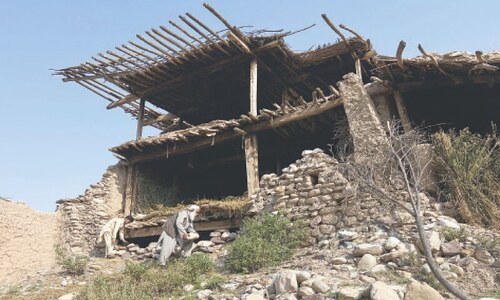PESHAWAR: As health authorities race to ratchet up their testing capabilities, the mounting number of Covid-19 fatalities in Khyber Pakhtunkhwa has left many of them to wonder whether the spread of the deadly virus is far more than what has been reported.
KP reported a total of 161 coronavirus fatalities on Friday, including the 15 previously unreported and unconfirmed deaths that have now been added to the tally. These included suspected patients for whom swabs had been taken post-mortem but were reported after confirmation of the virus or their records were managed at the district level and were only now being added to KP’s database.
Similarly, the figures for positive virus-afflicted patients also saw a jump of 68 previously unreported cases from the districts, taking the total number to 2,799. This puts the total mortality rate for KP at 5.75 per cent, more than double the national fatality rate from the deadly virus of 2.2pc and far more when compared with the reported deaths from other provinces.
Hardest-hit Peshawar accounts for 59.6pc of total deaths in province
Peshawar, the capital of this northwestern province, has been the hardest hit, reporting 96 deaths since the reported onset of the virus in February, that’s 59.6pc of the total mortalities in KP.
Even though, researchers are still trying to figure out how many of those fallen victim had come from outside of Peshawar. And if Peshawar’s confirmed fatalities from the virus are divided against the total confirmed positive cases of 1,009 since the outbreak of the pandemic in this part of the nook, the percentage comes to an alarming 9.5 deaths per one hundred patients per day.
What is going on? Is there any possible explanation in this data-disparity between KP and other provinces, besides Azad Jammu and Kashmir and Gilgit-Baltistan? Are the provinces using a uniform data collection methodology for data or is KP using a more rigorous and transparent system? Do we know the actual spread of the virus? The bottom line: Are we being transparent?
And while it would entirely depend on how data related to deaths from Covid-19 is collected and whether or not we take post-mortem swabs of the patients, these fatalities may give us a clue or two as to the spread and management of the deadly virus, according to health professionals.
KP’s number-crunching statistician Health Minister Taimur Saleem Jhagra says it is the data which reflects the ground reality given the lack of testing capabilities all across Pakistan.
According to the World Health Organisation, however, KP has the second lowest testing ratio after AJK, though the minister says its testing capacity has been scaled up to 1,500 per day and it is testing at a higher daily per population rate than Punjab.
He insists that the fatality rate is not accurate measure, because the total actual number of cases is unknown even in more developed countries, while referring to the mortality rates in the United States, the United Kingdom, Spain and Italy. But he also believes that if anything, greater number of deaths in KP indicates that the spread of the virus is far more than what testing capacity reveals, modelling done shows — anywhere from 30,000 to 60,000 depending on the transmission rate.
Different theories are being propounded as to what could be the possible causes for the spread and by extension the fatalities of the pandemic in KP. One possible reason could be the provinces are following different reporting systems and data collection methodology and or some provinces are “fudging the numbers” to downplay the impact of the pandemic, health officials maintain.
On KP’s part, it has established an Integrated Performance Management System to collate information from all districts, while analysts at the health department, some hired from the private sector, huddle to analyse the data and make future projection. “I don’t believe in ‘garbage-in, garbage-out’,” Mr Jhagra argues.
The second plausible theory is KP’s widespread diaspora across Pakistan and globally. More than 60,000 international travelers, particularly from the Gulf and the Middle East with KP domicile returned to the province post-pandemic; arrived in the provincial capital and then moved to their respective districts, according to government officials.
The problem was further accentuated by the arrival to KP of Tablighee Jamaat teams and Zaireen from Taftan with higher positive cases. This would also explain why the virus has afflicted more districts of KP — 33 of the 35 districts — than any other province. The remote northern districts of Kohistan Lower and Kolai Pallas are the only two districts that have so far remained unaffected or are probably unable to report any cases.
Prof Dr Ziaul Haq, Dean Public Health, Khyber Medical University, says fatalities in KP had more to do with health-seeking behavior of its people leading to delayed hospitalisation.
His research into the deaths occurred on account of Covid-19 led to a startling discovery that the median stay of the ill-fated patients at hospital was only one day.
To add further to the burden of an already overburdened healthcare system in Peshawar, more and more patients from other districts head straight towards the provincial capital, thus missing crucial and timely medical intervention closer to home, he says. Stigmatisation of the Covid-19 patients and cultural sensitivities related to an honorable burial are some of the other factors keeping the patients away from reporting to hospitals, he maintains.
One other major factor, says the professor, could be different treatment protocols being pursued by different hospitals, including some of the medical teaching hospitals, which are administratively ‘independent’ and, therefore, are not obliged to follow a standard protocol.
In fact, it is not even known if the federal government is sharing any clinical advisory with the provinces for the treatment of Covid-19 patients while learning from global experiences or whether the provinces are sharing any standard treatment protocols with districts.
Mixed messaging regarding the fatal threat of the pandemic, coupled with a lack of effective communication strategy to persuade people to stay home and observe social distancing and a somewhat faulty management system, are the other major contributing factors leading to the spread of the virus.
Pakistan’s and KP’s mortality and infection figures are still far below the global toll the pandemic has taken, but health professionals warn that any complacency and yet-to-be-tested beliefs could have far more devastating consequences for the country with poor healthcare system and infrastructure.
Published in Dawn, May 2nd, 2020




































